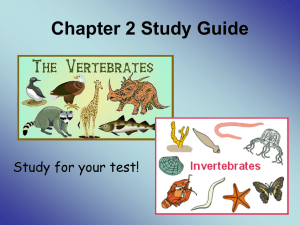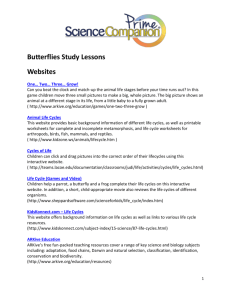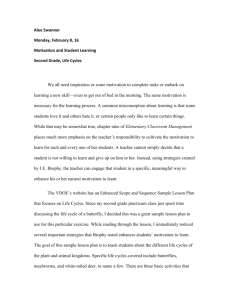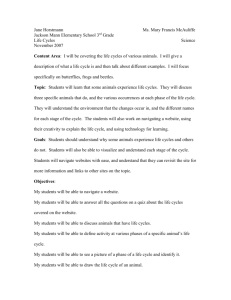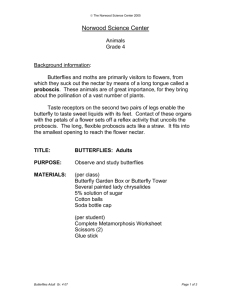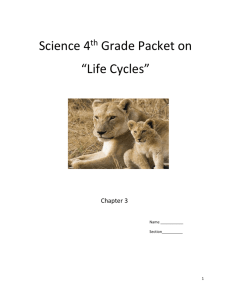Educator Guide: Life Cycles
advertisement
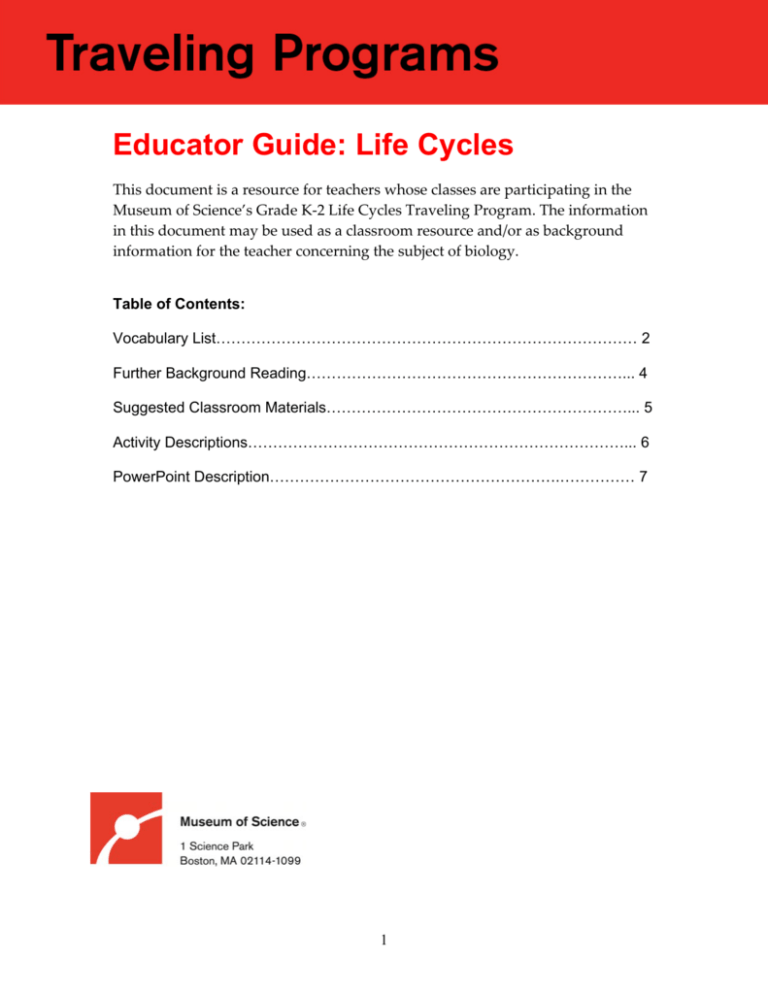
Educator Guide: Life Cycles This document is a resource for teachers whose classes are participating in the Museum of Science’s Grade K‐2 Life Cycles Traveling Program. The information in this document may be used as a classroom resource and/or as background information for the teacher concerning the subject of biology. Table of Contents: Vocabulary List………………………………………………………………………… 2 Further Background Reading………………………………………………………... 4 Suggested Classroom Materials……………………………………………………... 5 Activity Descriptions…………………………………………………………………... 6 PowerPoint Description………………………………………………….…………… 7 1 Vocabulary List This is a list of common terms used in the discussion of life cycles that teachers may wish to be familiar with for the Life Cycles program. Teachers may also wish to prepare their students for participation in the program by introducing them to the vocabulary, though prior study of these words in not required for student participation. Adult – any organism that has completed development Animal – a multicellular organism of the kingdom Animalia, differing from plants in certain typical characteristics such as capacity for voluntary movement, nonphotosynthetic metabolism, restricted growth, and fixed bodily structure. Amphibian – a cold‐blooded, smooth‐skinned vertebrate of the class Amphibia, such as a frog or salamander, that characteristically hatches as an herbivorous aquatic larva with gills. The larva then goes through a metamorphosis and transitions into an adult with air‐breathing lungs. Biology – the study of life Bird – a warm‐blooded, egg‐laying, feathered vertebrate of the class Aves, having forelimbs modified to form wings. Egg – one of the round or oval female reproductive bodies of various animals. An egg usually consists of an embryo surrounded by nutrient material and a protective covering, like a shell. Embryo – any animal at any time before full development, birth, or hatching Invertebrate – an animal that does not have a backbone Juvenile – an animal or plant that is no longer an infant or seedling, but has not fully matured Life Cycle Stages – any point along the way as an organism develops that is marked by unique properties and/or forms. The stages discussed in the program are usually: embryo, newborn/seedling, juvenile, and adult. 2 Mammal – a warm‐blooded vertebrate animal of the class Mammalia, which includes humans. Mammals are characterized by a covering of hair on the skin and, in the female, milk‐producing mammary glands for nourishing the young. Metamorphosis – a change in the form and often the habits of an animal during normal development. Metamorphosis includes, in insects, the transformation of a maggot into an adult fly and a caterpillar into a butterfly and, in amphibians, the changing of a tadpole into a frog. Newborn – any animal that has completed gestation, but has not developed sufficiently to be called a juvenile Plant – a multicellular organism of the kingdom Plantae that usually produces its own food through photosynthesis, has rigid cell walls, and lacks the power of locomotion Reproduce – to create offspring Reptile – a cold‐blooded, usually egg‐laying vertebrate of the class Reptilia, such as a snake, lizard, crocodile, or turtle; that have an external covering of scales or horny plates and breathe with lungs. Seed – the plant version of an egg. Seeds contain a plant embryo surrounded by a protective covering, just like an egg! Vertebrate – an animal with a backbone 3 Further Background Reading This is a suggested reading list for teachers looking to improve their understanding of biological life cycles. Books Hands-On Herpetology: Exploring Ecology and Conservation by Rebecca L. Schneider, Marianne E. Kransny and Stephen J. Morreale. NSTA press. 2001 Cats and Other Mammals by Sally Morgan. Belitha Press Ltd. 2001 Animal: the Definitive Visual Guide to the World’s Wildlife by David Burnie. DK Adult. 2005. Animal Life: Secrets of the Animal World Revealed by DK Publishing. DK Adult. 2008. Links Animal Diversity Web (detailed information about particular animal species) – http://animaldiversity.ummz.umich.edu/site/index.html National Geographic’s Animal Facts pages – http://animals.nationalgeographic.com/animals/facts/ ARKive (images and facts about endangered species around the world) – http://www.arkive.org/ 4 Classroom Materials Below are some suggestions for books, videos, and websites to help students increase their understanding of life cycles. Books The Very Hungry Caterpillar by Eric Carle. Philomel. 1994 Animal Life Cycles: Growing and Changing by Bobbie Kalman. Crabtree Publishing Company. 2008. Watch Me Grow series by Lisa Magloff. DK Publishing. 2004-2006. Video Bill Nye the Science Guy: Insects and Reptiles - Leapin’ Lizards! 1995. Links Children’s Butterfly Site – http://www.kidsbutterfly.org/ All About Frogs – http://www.kiddyhouse.com/Themes/frogs/ Metamorphosis Videos – http://www.neok12.com/Metamorphosis.htm 5 Activity Descriptions See the “Documents” section on the website to download these activities. Build a Butterfly This is a fun “make and take” activity for younger learners. In this activity students will make a butterfly out of coffee filters, washable markers, pipe cleaner, clothespins and a small amount of water. They will also make a diagram showing the other stages in the life cycle of a butterfly so they can see where their free‐flying creation fits in the life cycle. A great extension would be to make paper flowers for the butterflies to visit, or to find flowers outside that real butterflies would visit to talk about the life style of a butterfly as well as the life cycle. Butterflies and Plants This activity is a great way to show students how plants play an important role in every life cycle stage of a butterfly. This is a great way for students to be as creative as they want while exploring the different ways plants provide food and shelter for butterflies, pupae, caterpillars and eggs. Frog Form and Function This is a great interactive activity that will get everybody up and hopping around! The goal is to get the students to think seriously about what features tadpoles and frogs have to help them survive in the water and on the land. With the use of props to represent these features, this activity is a great way to represent these adaptations in a fun and interactive way. In lieu of props you can always ask the students to get up and move around the same way a tadpole does and have them pretend they are slowly going through metamorphosis and becoming frogs. 6 PowerPoint Description See the “Documents” section of the website to download the PDF of this PowerPoint. Life Cycles This is a basic version of the PowerPoint that the educator used/will use in your classroom. It has the basic life cycle stages, as well as pictures, of a mammal, a plant, an amphibian, a reptile, a bird and an insect. Great to either prepare students for the presentation by getting them used to the vocabulary, or for review afterwards. 7

